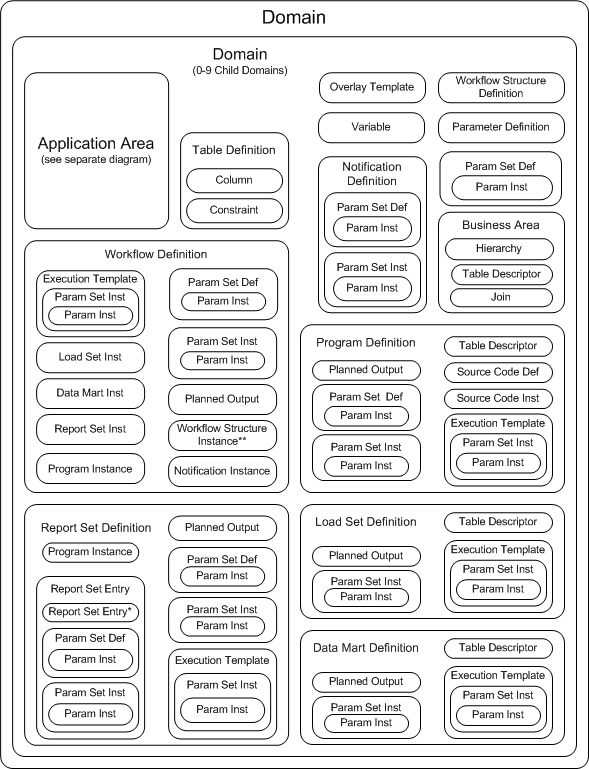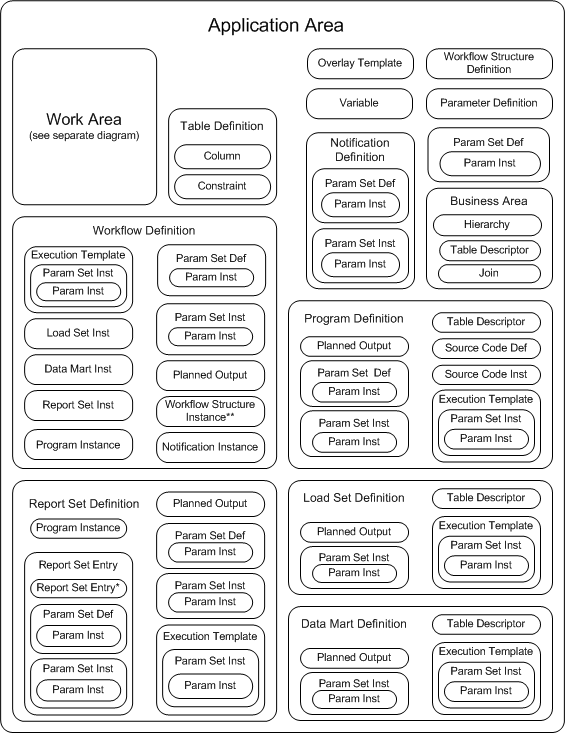| Oracle® Life Sciences Data Hub Application Developer's Guide Release 2.3.1 E35298-02 |
|
 Previous |
 Next |
| Oracle® Life Sciences Data Hub Application Developer's Guide Release 2.3.1 E35298-02 |
|
 Previous |
 Next |
In the Oracle Life Sciences Data Hub (Oracle LSH), object definitions and instances are "owned" by their immediate container object. The following diagrams show the Oracle LSH data model for object ownership:
Object ownership has ramifications in many areas of Oracle LSH, including security (user group assignments) and classification; it is possible for objects to inherit the user group assignments and classifications of their owning objects. In addition, Oracle LSH enforces unique names for objects of the same type in the same container object.
Domains contain Application Areas and object definitions. Depending on the setting of the Object definitions contained directly in a Domain constitute the Domain library.
In addition, Domains can contain child Domains that themselves contain child Domains, up to nine (9) levels, depending on the value of the Domain Nest Value profile setting for your LSH implementation. A Domain can contain any number of Domains at a single level. For example, if the Domain Nest Value profile is set to one (1), a top-level Domain can contain any number of child Domains, but those child Domains cannot contain any child Domains of their own.
The various objects contained within a Domain are as follows:
Application Areas. The objects contained in the Application Area are listed separately.
Table Definitions. These contain—Columns and Constraints.
Workflow Definitions. These contain:
Execution Templates containing Parameter Set Instances that in turn, contain Parameter Instances
Load Set Instances
Data Mart Instances
Report Set Instances
Program Instances
Parameter Set Instances that contain Parameter Instances
Parameter Set Definitions that contain Parameter Instances
Planned Outputs
Workflow Structure Instances
Notification Instances
Report Set Definitions. These contain:
Program Instances
Report Set Entries. These contain—Report Set Entries, Parameter Set Definitions containing Parameter Instances, Parameter Set Instances containing Parameter Instances
Planned Outputs
Parameter Set Instances that contain Parameter Instances
Parameter Set Definitions that contain Parameter Instances
Execution Templates. These contain Parameter Set Instances that in turn, contain Parameter Instances.
Overlay Templates
Variables
Notification Definitions. These contain Parameter Set Definitions containing Parameter Instances and Parameter Set Instances containing Parameter Instances.
Workflow Structure Definitions
Parameter Definitions
Parameter Set Definitions containing Parameter Instances
Business Areas. These contain—Hierarchies, Table Descriptors, Joins.
Program Definitions. These contain:
Planned Outputs
Parameter Set Definitions that contain Parameter Instances
Parameter Set Instances that contain Parameter Instances
Table Descriptors
Source Code Definitions
Source Code Instances
Execution Templates. These contain Parameter Set Instances that in turn, contain Parameter Instances.
Load Set Definitions. These contain:
Planned Outputs
Parameter Set Definitions that contain Parameter Instances
Parameter Set Instances that contain Parameter Instances
Table Descriptors
Execution Templates. These contain Parameter Set Instances that in turn, contain Parameter Instances.
Data Mart Definitions. These contain:
Planned Outputs
Parameter Set Definitions that contain Parameter Instances
Parameter Set Instances that contain Parameter Instances
Table Descriptors
Execution Templates. These contain Parameter Set Instances that in turn, contain Parameter Instances.
Figure B-1 shows all layers of object ownership within a Domain, except for objects contained in the Application Area. See Figure B-2 for object ownership within an Application Area.
|
Note: Report Set Entries inside Report Set Definitions can be nested indefinitely. |
Figure B-1 Object Ownership within a Domain

Application Areas contain exactly the same objects as Domains, except that Domains contain Application Areas and Application Areas contain Work Areas. Both Domains and Application Areas can include all object definition types. Figure B-2 shows all possible layers of object ownership within an Application Area.
|
Note: Report Set Entries inside Report Set Definitions can be nested indefinitely. |
Figure B-2 Object Ownership within an Application Area

Work Areas contain object instances, each of which points to an object definition located either in an Application Area or in a Library. This diagram shows only object ownership, so you cannot see the pointers to the definitions. Most object instances point to an object definition with the same type name; for example, Program instances point to Program definitions. There are two exceptions: both a Parameter and a Table Column point to a Variable as their definition source.
Figure B-3 shows all possible layers of object ownership within a Work Area. The objects are Program Instances, Load Set Instances, Report Set Instances, Data Mart Instances, Work Flow Instances, each of which contain the following objects:
Table Descriptor to Table Instance mapping
Execution Setups. These contain Parameter Set Instances containing Parameter Instances, and Jobs containing Outputs.
In addition, Work Areas also contain:
Table Instances that contain Constraints
Business Area Instances that contain Table Descriptor to Table Instance mappings
Figure B-3 Object Ownership within a Work Area
